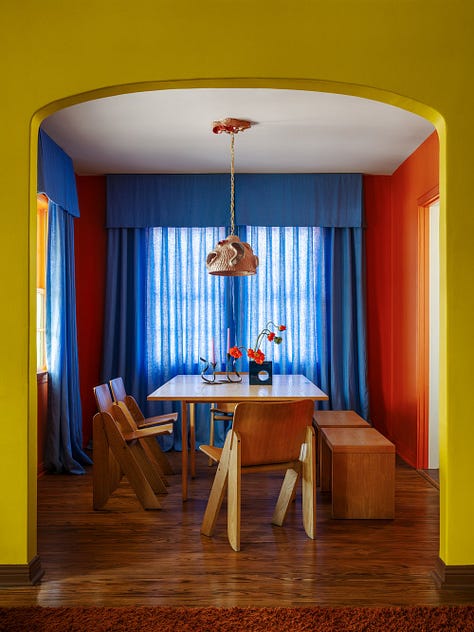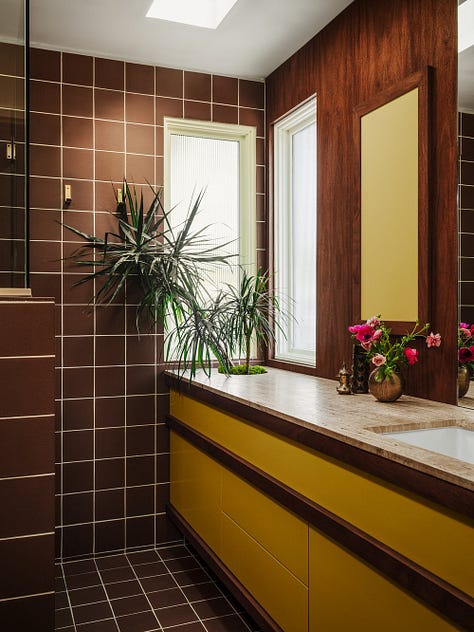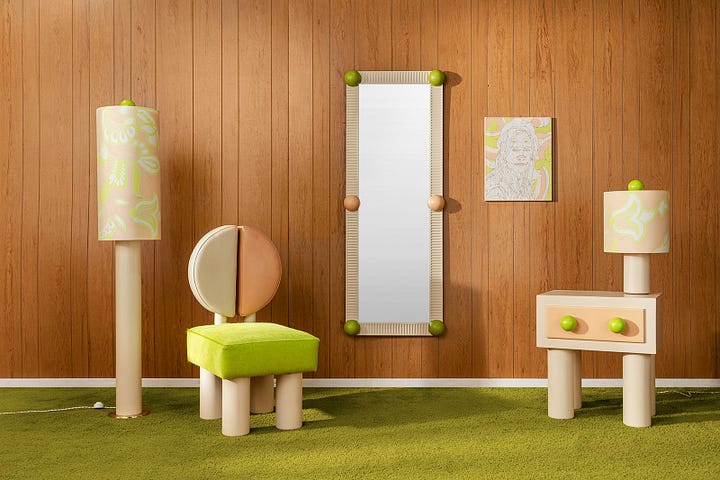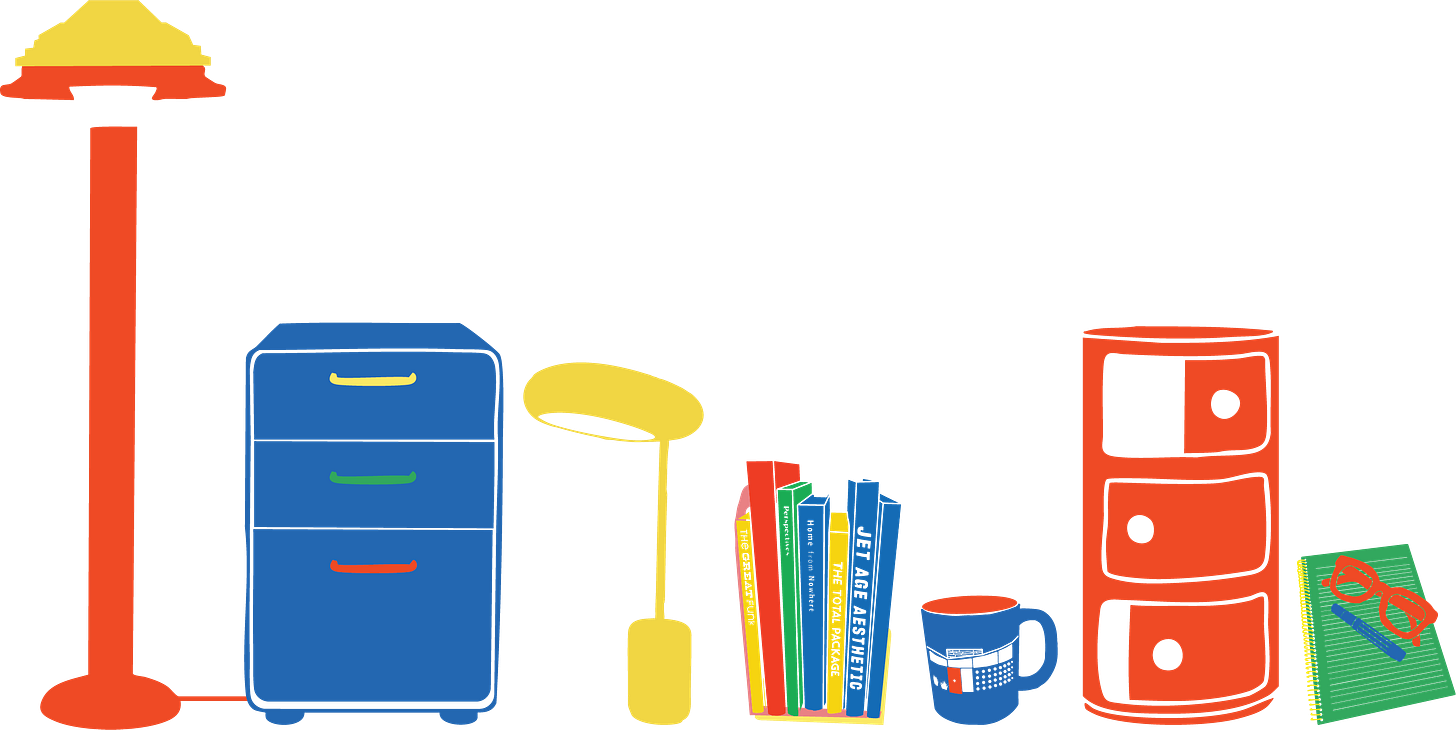On The Moodboard: Another Human's Imaginative Worlds
From Gae Aulenti's apartment to a Swedish techno pump up track, here's what inspires Leah Ring
You’re reading the second edition of ‘On the Moodboard,’ a column in which I talk to some of my favorite designers working today about the references that enliven their work. The references could be high brow or low brow, well-known or totally unknown.
My conversation with Leah Ring, the founder of the design studio Another Human, begins with what’s not on her moodboard. Namely, the 1992 movie Robin Williams movie Toys. So far it’s come up in both of the published On The Moodboard interviews. “I saw Sophie's and I was like, ‘Man, she took Toys,’” Ring says. “That would have been on mine. It's just so good.” From what I’ve pieced together from YouTube clips alone, it’s easy to understand what Ring likes about the zany film. One particular room of hers, entirely covered in cloud wallpaper (photograph above) feels like a direct nod to a hallway painted with clouds in Toys.1



What excites me most about Ring’s work across interiors and furniture design is the skillful way she deploys color. I resist the word “bold” to describe use of color, which seems to imply there’s something to be genuinely fearful about when venturing past neutrals. To me, it also diminishes the particular tools any given designer uses to harness the power of different hues. Ring gives her colors real depth with the specific materials and textures she uses to introduce them to a space. This adds to a sense of livability, too. She never seems to lose sight of bringing a sense of warmth, even if a room is drenched in a color that others might consider off limits. Each room has a strong and distinct mood of its own, which I think can be hard to achieve in project after project, year after year.


I first encountered Another Human’s work years ago and first interviewed her for a 2023 AD article on her redesign of a home that some of you may recognize from Transparent. From interior design projects to furniture designs, Another Human’s output has stayed on my own moodboard for years, so I was glad to hear what inspires Leah’s creativity.

The reference: Ettore Sottsass’s showroom designs for Esprit from the late ‘80s
RING: I had been familiar with more of Sottsass's product work and here you really see how his brain applied that same design ethos on a larger scale. It's just so playful. Also, like, they're in Germany, not exactly known for being the life of the party. Just imagining all of these German executives in the '80s, in their suits with big shoulder pads in these ridiculous spaces, it just makes me so happy.
I loved Esprit, like that was a serious business. They created these spaces that encourage creativity and encourage a sense of play. This is for adults. I think if people saw these, they might be like, "Is this like a kid's school?" Like, no, no, no. This is a very serious corporate company.
When I discovered this, I was like, "Oh, I didn't know this was an option." Like, to really push things this far. Obviously he's a hero of mine too, so he can do no wrong.
The reference: AIR’s “Don’t Be Light” music video
RING: I'm a big music fan. It's really important to my creative process. I love AIR in general, but the animation style of this video I found so interesting. I think it's sort of the way that my brain works when I'm designing, like this morphs into this, morphs into this. You have to allow your brain to work that way to find the cool ideas. You have to let it just wander from thing to thing. It's such a rudimentary illustration and I just think it's cool every time. I never get sick of watching it.
I only ever talk to students, who are like, "Where do you find inspiration?" I'm like, "Literally everywhere." I could see some trash on the ground that's in a weird color. And then that would make me think of this, and that would make me think of this. You have to let yourself sort of be in a flow state, which can be hard. I try to carve out separate design time because so much of interiors is like, project management, so my best design happens on nights and weekends when no one's bugging me and I can just really flow.
DAVIES: Do you ever feel burnt out on taking things in?
RING: I don't feel burnt out on taking things in. I feel burnt out on email. The creative is, I don't know, 10 to 20% of the job. There's just so much logistics. The outcome is that install day is like the best day of your life. It's so exciting. Every time you're like, "I can't believe it, it was in my brain and now it's here!" It's worth all the logistics.
The reference: Joe Colombo’s Visiona 1, “Habitat of the Future,” 1969
DAVIES: What qualities stand out to you about this space?
RING: Because it is from 1969, it still looks futuristic, but it looks retro. It looks like, for the 60s, it’s very high tech, but it's still comfortable, right? You have the plush carpet, you have these soft upholster things, you have these cushions. So I think it's an interesting push and pull. It's like a conversation pit on a spaceship. How do we make that work?
I think a lot of what I try to do too, especially when I designed more furniture and was doing photo shoots, a lot of it was world building, like sort of creating fantasy spaces. We get to do that a little bit with our clients, but, you know, they live there. But I just love this sort of total vision, and the idea of stepping into a whole other world. Outer space is so powerful in that way and I think there's a lot of missed opportunities and a lot of beige. Like, we can have fun!
The reference: Lindstrøm’s “Closing Shot”
RING: If I know I have eight hours of drafting to do, and I need to dive into a drawing set, this is the song I put on. It's become one of my pump up songs. It's eight minutes long. I have had many solo dance parties by myself to this. I like running to it. I like a big variety of music, and I'm not typically that into techno, but this song just tells my brain to click in and really rip through some work. There's no lyrics so you can get really lost in it.

The reference: architect and designer Gae Aulenti’s apartment
RING: It's my dream. It's light, it's airy, it's modern, but it's layered. There's a red catwalk across the top and a steel and blue frame table, but then there's vintage, global textiles. I just think everything about it is perfect. I would move in. She's also such a badass, and just to be working at a time when, like, there were so few female architects working and she has such a singular vision. A lot of the spaces that she designed for private clients were much more, like minimal and austere. Really cool, but I don't know, I like this more. I'm looking at the shot with the bookshelves and the catwalk. Seeing the books, and seeing the art, and seeing the objects, I think it's more how people live.
I think that was a really nice thing that I learned from [working at Reath before starting my own firm.]2 So many interior designers, when you see the photographs, you're like, "Yeah, but where is their stuff?" [Reath founder and principal Francis Merrill] was like, "No, no, let's leave the books messy on the shelf and have the kids toys out. This is how people actually live." And I think that's what's so beautiful about about Gae Aulenti's space is there's her knickknacks and collectibles and stuff. I think it's so interesting to see the way people actually live, that isn't just like styled for a photograph. To see the way such a great creative mind [lived], like here's all of her reading material, and this is where she napped. It's like my dream space.
Discover more of Another Human’s work on the studio’s website or on Instagram.
Solely for trivia purposes, I will also note that Toys was directed by Barry Levinson, director of Rain Man and father of Euphoria creator Sam Levinson.
If you’re unfamiliar with Reath, this Massachusetts home featured by AD is a great place to start. I adore the painted trim in this house.







